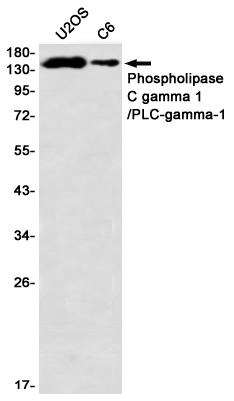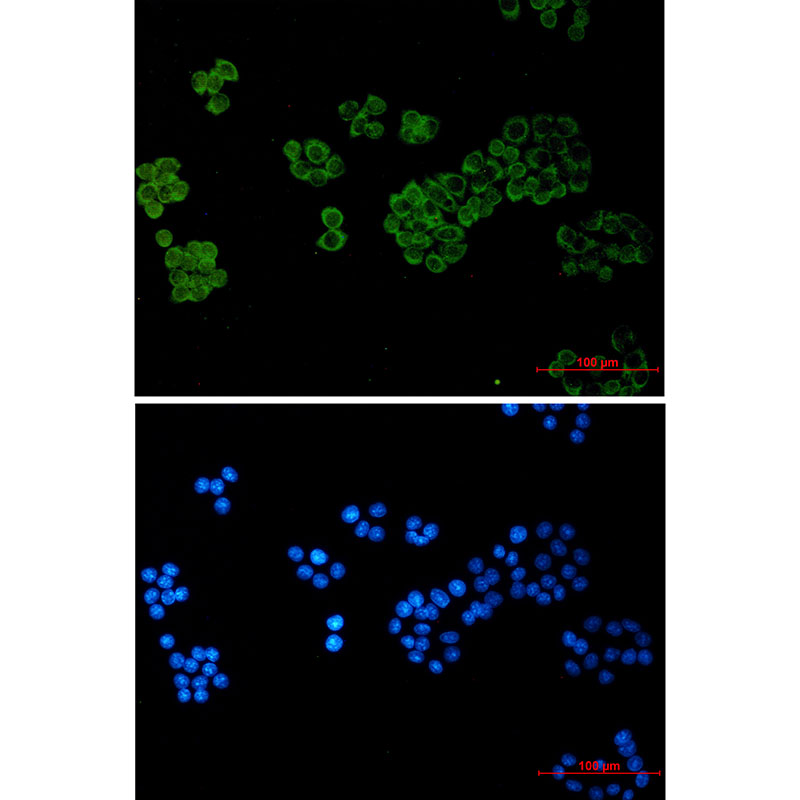

| WB | 1/500-1/1000 | Human,Mouse,Rat |
| IF | 1/20 | Human,Mouse,Rat |
| IHC | 咨询技术 | Human,Mouse,Rat |
| ICC | 1/50-1/200 | Human,Mouse,Rat |
| FCM | 咨询技术 | Human,Mouse,Rat |
| Elisa | 咨询技术 | Human,Mouse,Rat |
| Aliases | PLCG1; PLC1; 1-phosphatidylinositol 4; 5-bisphosphate phosphodiesterase gamma-1; PLC-148; Phosphoinositide phospholipase C-gamma-1; Phospholipase C-II; PLC-II; Phospholipase C-gamma-1; PLC-gamma-1 |
| Entrez GeneID | 5335 |
| WB Predicted band size | Calculated MW: 149 kDa; Observed MW: 149 kDa |
| Host/Isotype | Rabbit IgG |
| Antibody Type | Primary antibody |
| Storage | Store at 4°C short term. Aliquot and store at -20°C long term. Avoid freeze/thaw cycles. |
| Species Reactivity | Human,Rat |
| Immunogen | A synthetic peptide of human Phospholipase C gamma 1/PLC-gamma-1 |
| Formulation | Purified antibody in TBS with 0.05% sodium azide,0.05%BSA and 50% glycerol. |
+ +
以下是关于Phospholipase C gamma 1(PLCγ1)抗体的3篇参考文献,按作者和摘要内容简要概括:
1. **文献名称**:*"Characterization of a monoclonal antibody specific for phospholipase C-γ1 and its application in studying intracellular signaling"*
**作者**:Anderson, D., Koch, C.A., & Grey, L.
**摘要**:该文献描述了一种针对PLCγ1的单克隆抗体的开发,通过免疫印迹和免疫荧光验证其特异性,并用于研究生长因子刺激下PLCγ1的亚细胞定位及酪氨酸磷酸化调控机制。
2. **文献名称**:*"Binding of phospholipase C-γ1 to the epidermal growth factor receptor is mediated by its SH2 domains"*
**作者**:Suh, P.G., Ryu, S.H., Moon, K.H., et al.
**摘要**:研究利用PLCγ1抗体通过免疫沉淀技术证明,PLCγ1的SH2结构域介导其与激活的EGF受体结合,揭示了生长因子信号转导中PLCγ1的招募机制。
3. **文献名称**:*"Production and application of polyclonal antibodies to phospholipase C isozymes"*
**作者**:Meisenhelder, J., Suh, P.G., Rhee, S.G., et al.
**摘要**:该研究报道了针对PLCγ1的多克隆抗体制备方法,验证其在免疫印迹、免疫组化中的特异性,并用于比较不同组织及细胞中PLCγ1的表达水平差异。
以上文献均聚焦于PLCγ1抗体的开发、验证及其在信号转导研究中的应用。如需更多细节,建议通过PubMed或学术数据库检索具体标题。
Phospholipase C gamma 1 (PLCγ1) is a critical enzyme in intracellular signaling, primarily involved in hydrolyzing phosphatidylinositol 4.5-bisphosphate (PIP2) into diacylglycerol (DAG) and inositol 1.4.5-trisphosphate (IP3). These secondary messengers regulate calcium release and protein kinase C (PKC) activation, influencing processes like cell proliferation, differentiation, and apoptosis. PLCγ1 is activated by receptor tyrosine kinases (RTKs) or non-receptor tyrosine kinases through phosphorylation, particularly at tyrosine residues (e.g., Y783), which facilitates its recruitment to signaling complexes via SH2 domains.
Antibodies targeting PLCγ1 are essential tools for studying its expression, localization, and activation in various biological contexts. They are widely used in techniques such as Western blotting, immunoprecipitation, and immunofluorescence to investigate PLCγ1’s role in signaling pathways like Ras/MAPK and PI3K/Akt. These antibodies often detect specific phosphorylation sites (e.g., anti-pY783) to assess activation status.
Dysregulation of PLCγ1 is implicated in cancers, immune disorders, and neurological diseases. For example, PLCγ1 mutations or overexpression are observed in certain tumors, linking it to oncogenic signaling and metastasis. Antibodies against PLCγ1 also aid in evaluating its potential as a therapeutic target or biomarker. Researchers prioritize antibodies with high specificity to avoid cross-reactivity with PLCγ2. a closely related isoform. Overall, PLCγ1 antibodies are pivotal for unraveling its mechanistic contributions to cellular physiology and pathology.
×